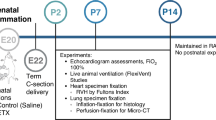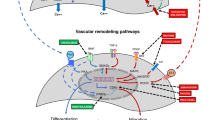Abstract
Background
Inflammation is a key factor in the pathogenesis of bronchopulmonary dysplasia (BPD). Tumor necrosis factor–stimulated protein 6 (TSG-6) is a glycoprotein that modulates inflammation. Here we tested the hypothesis that intra-tracheal (IT) administration of an adenovirus overexpressing TSG-6 (AdTSG-6) would decrease inflammation and restore lung structure in experimental BPD.
Methods
Newborn Sprague-Dawley rats exposed to normoxia (RA) or hyperoxia (85% O2) from postnatal day (P) 1–P14 were randomly assigned to receive IT AdTSG-6 or placebo (PL) on P3. The effect of IT AdTSG-6 on lung inflammation, alveolarization, angiogenesis, apoptosis, pulmonary vascular remodeling, and pulmonary hypertension were evaluated on P14. Data were analyzed by two-way ANOVA.
Results
TSG-6 mRNA was significantly increased in pups who received IT AdTSG-6. Compared to RA, hyperoxia PL-treated pups had increased NF-kβ activation and lung inflammation. In contrast, IT AdTSG-6 hyperoxia-treated pups had decreased lung phosphorylated NF-kβ expression and markers of inflammation. This was accompanied by an improvement in alveolarization, angiogenesis, pulmonary vascular remodeling, and pulmonary hypertension.
Conclusions
IT AdTSG-6 decreases lung inflammation and improves lung structure in neonatal rats with experimental BPD. These findings suggest that therapies that increase lung TSG-6 expression may have beneficial effects in preterm infants with BPD.
Similar content being viewed by others
Log in or create a free account to read this content
Gain free access to this article, as well as selected content from this journal and more on nature.com
or
References
Coalson, J. J. Pathology of new bronchopulmonary dysplasia. Semin. Neonatol. 8, 73–81 (2003).
Walsh, M. C. et al. Impact of a physiologic definition on bronchopulmonary dysplasia rates. Pediatrics 114, 1305–1311 (2004).
Stoll, B. J. et al. Neonatal outcomes of extremely preterm infants from the NICHD Neonatal Research Network. Pediatrics 126, 443–456 (2010).
Stoll, B. J. et al. Trends in care practices, morbidity, and mortality of extremely preterm neonates, 1993–2012. JAMA 314, 1039–1051 (2015).
Jobe, A. H. & Bancalari, E. Bronchopulmonary dysplasia. Am. J. Respir. Crit. Care Med. 163, 1723–1729 (2001).
Munshi, U. K., Niu, J. O., Siddiq, M. M. & Parton, L. A. Elevation of interleukin-8 and interleukin-6 precedes the influx of neutrophils in tracheal aspirates from preterm infants who develop bronchopulmonary dysplasia. Pediatr. Pulmonol. 24, 331–336 (1997).
Lee, T. H., Wisniewski, H. G. & Vilcek, J. A novel secretory tumor necrosis factor-inducible protein (TSG-6) is a member of the family of hyaluronate binding proteins, closely related to the adhesion receptor CD44. J. Cell Biol. 116, 545–557 (1992).
Maina, V. et al. Coregulation in human leukocytes of the long pentraxin PTX3 and TSG-6. J. Leuk. Biol. 86, 123–132 (2009).
Coulson-Thomas, V. J. et al. Tumor necrosis factor-stimulated gene-6 (TSG-6) is constitutively expressed in adult central nervous system (CNS) and associated with astrocyte-mediated glial scar formation following spinal cord injury. J. Biol. Chem. 291, 19939–19952 (2016).
Forteza, R. et al. TSG-6 potentiates the antitissue kallikrein activity of inter–α-inhibitor through bikunin release. Am. J. Resp. Cell Mol. Biol. 36, 20–31 (2007).
Wisniewski, H. G. & Vilcek, J. TSG-6: An IL-1/TNF-inducible protein with anti-inflammatory activity. Cytokine Growth Factor Rev. 8, 143–156 (1997).
Lee, R. H. et al. Intravenous hMSCs improve myocardial infarction in mice because cells embolized in lung are activated to secrete the anti-inflammatory protein TSG-6. Cell Stem Cell 5, 54–63 (2009).
Liu, L. et al. TSG-6 secreted by human umbilical cord-MSCs attenuates severe burn-induced excessive inflammation via inhibiting activations of p38 and JNK signaling. Sci. Rep. 6, 30121 (2016).
Lee, R. T. et al. Mechanical strain induces specific changes in the synthesis and organization of proteoglycans by vascular smooth muscle cells. J. Biol. Chem. 276, 13847–13851 (2001).
Margerie, D. et al. Complexity of IL-1 beta induced gene expression pattern in human articular chondrocytes. Osteoarthr. Cartil. 5, 129–138 (1997).
Milner, C. M., Higman, V. A. & Day, A. J. TSG-6: a pluripotent inflammatory mediator? Biochem. Soc. Trans. 34, 446–450 (2006).
Parkar, A. A. & Day, A. J. Overlapping sites on the link module of human TSG-6 mediate binding to hyaluronan and chrondroitin-4-sulphate. FEBS Lett. 410, 413–417 (1997).
Mittal, M. et al. TNFα-stimulated gene-6 (TSG6) activates macrophage phenotype transition to prevent inflammatory lung injury. Proc. Natl. Acad. Sci. USA 113, E8151–E8158 (2016).
Bourbia, A., Cruz, M. A. & Rozycki, H. J. Nf-κb in tracheal lavage fluid from intubated premature infants: association with inflammation, oxygen, and outcome. Arch. Dis. Child Fetal Neonatal Ed. 91, F36–F39 (2006).
Foskett, A. M. et al. Phase-directed therapy: TSG-6 targeted to early inflammation improves bleomycin-injured lungs. Am. J. Physiol. Lung Cell Mol. Physiol. 306, L120–L131 (2014).
Swaidani, S. et al. TSG-6 protein is crucial for the development of pulmonary hyaluronan deposition, eosinophilia, and airway hyperresponsiveness in a murine model of asthma. J. Biol. Chem. 288, 412–422 (2013).
Oh, J. Y. et al. Anti-inflammatory protein TSG-6 reduces inflammatory damage to the cornea following chemical and mechanical injury. Proc. Natl. Acad. Sci. USA 107, 16875–16880 (2010).
Chaubey, S. et al. Early gestational mesenchymal stem cell secretome attenuates experimental bronchopulmonary dysplasia in part via exosome-associated factor TSG-6. Stem Cell Res. Ther. 9, 173 (2018).
Young, K. C. et al. Inhibition of the SDF-1/CXCR4 axis attenuates neonatal hypoxia-induced pulmonary hypertension. Circ. Res. 104, 1293–1301 (2009).
Miranda, L. F. et al. Stem cell factor improves lung recovery in rats following neonatal hyperoxia-induced lung injury. Pediatr. Res. 74, 682–688 (2013).
Cooney, T. P. & Thurlbeck, W. M. The radial alveolar count method of Emery and Mithal: a reappraisal 2–intrauterine and early postnatal lung growth. Thorax 37, 580–583 (1982).
Choi, H., Lee, R. H., Bazhanov, N., Oh, J. Y. & Prockop, D. J. Anti-inflammatory protein TSG-6 secreted by activated mscs attenuates zymosan-induced mouse peritonitis by decreasing TLR2/NF-kappab signaling in resident macrophages. Blood 118, 330–338 (2011).
Bertling, F. et al. Tumor necrosis factor-inducible gene 6 protein: a novel neuroprotective factor against inflammation-induced developmental brain injury. Exp. Neurol. 279, 283–289 (2016).
Kohda, D. et al. Solution structure of the link module: a hyaluronan-binding domain involved in extracellular matrix stability and cell migration. Cell 86, 767–775 (1996).
Getting, S. J. et al. The link module from human TSG-6 inhibits neutrophil migration in a hyaluronan- and inter-alpha -inhibitor-independent manner. J. Biol. Chem. 277, 51068–51076 (2002).
Benjamin, J. T. et al. Nf-κb activation limits airway branching through inhibition of sp1-mediated fibroblast growth factor-10 expression. J. Immunol. 185, 4896–4903 (2010).
Iosef, C. et al. Inhibiting NF-κb in the developing lung disrupts angiogenesis and alveolarization. Am. J. Physiol. Lung Cell Mol. Physiol. 302, L1023–L1036 (2012).
Watanabe, R. et al. Atheroprotective effects of tumor necrosis factor–stimulated gene-6. JACC: basic to translational. Science 1, 494–509 (2016).
Velten, M., Heyob, K. M., Rogers, L. K. & Welty, S. E. Deficits in lung alveolarization and function after systemic maternal inflammation and neonatal hyperoxia exposure. J. Appl. Physiol. (1985) 108, 1347–1356 (2010).
Ward, N. S. et al. Interleukin-6–induced protection in hyperoxic acute lung injury. Am. J. Resp. Cell Mol. Biol. 22, 535–542 (2000).
Franco, M. L. et al. Lps-induced lung injury in neonatal rats: changes in gelatinase activities and consequences on lung growth. Am. J. Physiol. Lung Cell Mol. Physiol. 282, L491–L500 (2002).
Bhatt, A. J. et al. Disrupted pulmonary vasculature and decreased vascular endothelial growth factor, Flt-1, and tie-2 in human infants dying with bronchopulmonary dysplasia. Am. J. Resp. Crit. Care Med. 164, 1971–1980 (2001).
Kallapur, S. G., Jobe, A. H., Ikegami, M. & Bachurski, C. J. Increased IP-10 and MIG expression after intra-amniotic endotoxin in preterm lamb lung. Am. J. Respir. Crit. Care Med. 167, 779–786 (2003).
Bry, K., Whitsett, J. A. & Lappalainen, U. Il-1β disrupts postnatal lung morphogenesis in the mouse. Am. J. Respir. Cell Mol. Biol. 36, 32–42 (2007).
Coflesky, J. T., Adler, K. B., Woodcock-Mitchell, J., Mitchell, J. & Evans, J. N. Proliferative changes in the pulmonary arterial wall during short-term hyperoxic injury to the lung. Am. J. Pathol. 132, 563–573 (1988).
Author information
Authors and Affiliations
Corresponding author
Ethics declarations
Competing interests
The authors declare no competing interests.
Additional information
Publisher’s note: Springer Nature remains neutral with regard to jurisdictional claims in published maps and institutional affiliations.
Rights and permissions
About this article
Cite this article
Bryan, C., Sammour, I., Guerra, K. et al. TNFα-stimulated protein 6 (TSG-6) reduces lung inflammation in an experimental model of bronchopulmonary dysplasia. Pediatr Res 85, 390–397 (2019). https://doi.org/10.1038/s41390-018-0250-2
Received:
Accepted:
Published:
Issue date:
DOI: https://doi.org/10.1038/s41390-018-0250-2
This article is cited by
-
Exploring the therapeutic potential of MSC-derived secretomes in neonatal care: focus on BPD and NEC
Stem Cell Research & Therapy (2025)
-
Therapeutic effect of exogenous tumor necrosis factor-stimulating protein 6 intervention on lung injury in newborn rats by intrauterine infection
Scientific Reports (2025)
-
IL4I1-catalyzed tryptophan metabolites mediate the anti-inflammatory function of cytokine-primed human muscle stem cells
Cell Death Discovery (2023)
-
Molecular mechanisms of cell death in bronchopulmonary dysplasia
Apoptosis (2023)
-
RETRACTED ARTICLE: A paradigm shift in cell-free approach: the emerging role of MSCs-derived exosomes in regenerative medicine
Journal of Translational Medicine (2021)



